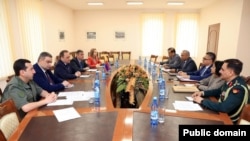According to the IDRW, Akash 1S, which is an upgraded version of the existing Akash missile, employs a combination of command guidance and active terminal seeker guidance to deal with aerial threats such as fighter jets, cruise missiles, and drones.
The report noted that Armenia placed an order for 15 Akash missile systems in 2022, with the total cost of the deal estimated at approximately US$720 million.
Last month the Indian government reportedly cited a lower total value for contracts signed between Armenia and Indian arms manufactures in the last few years, putting it at $600 million.
In a report cited by Russia’s TASS news agency on July 23 the Indian Finance Ministry described Armenia as the largest importer of weapons from India after the South Caucasus country concluded deals on the purchase of Pinaka multiple-launch rocket systems and Akash anti-aircraft systems.
Meanwhile, citing the Defense Ministry in New Delhi, the Indian Aerospace Defense News (IADN) publication reported last month that the “total volume of weapons purchases by Armenia from India reached $600 million by the start of current [financial year] 2024-25.” It gave no details of those deals.
India and Armenia have significantly deepened bilateral military cooperation since the 2020 war in Nagorno-Karabakh war during which India’s arch-foe Pakistan strongly supported Azerbaijan. Their multimillion-dollar defense contracts reportedly call for the delivery of not only Pinaka systems but also Indian-made howitzers, anti-tank rockets and anti-drone equipment to the Armenian army.
An Indian defense publication reported last September that Armenia is due to receive a total of 90 ATAGS howitzers over the next three years. Six of them have already been delivered to the South Caucasus nations, it said.
In May this year, military officials from the two countries held in Yerevan what the Armenian Defense Ministry described as first Indian-Armenian “defense consultations.” They set up a “working group” tasked with implementing a plan of joint actions for 2024 and 2025. The military cooperation will involve not only arms supplies but also military education, “tactical training” and “experience sharing,” according to the ministry.
Russia had long been Armenia’s principal supplier of weapons and ammunition. The Armenian government has been looking for alternative suppliers due to its growing tensions with Moscow and the continuing war in Ukraine that absorbs the bulk of military hardware manufactured in Russia. Since last October, Yerevan has also signed a number of arms deals with French companies.





Facebook Forum